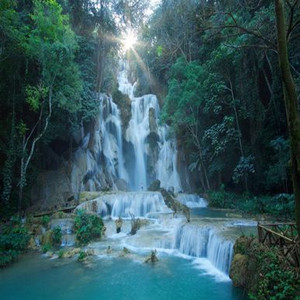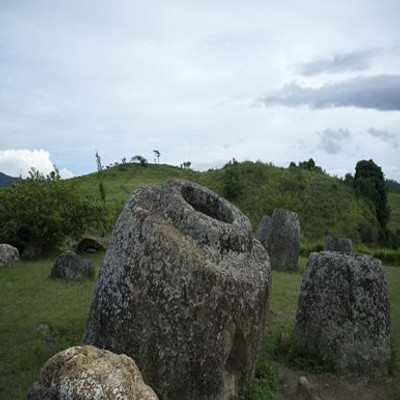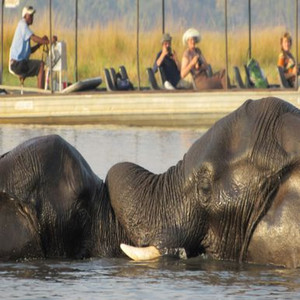
Duration: 8 Days | 7 Nights
Destination: Laos - Vientiane – Vang Vieng – Phonsavanh – Luang Prabang
Discover the enchanting wonders of Laos as you embark on a journey through four captivating destinations: Vientiane, Vang Vieng, Phonsavanh, and Luang Prabang.
In Vientiane, Laos' laid-back capital, immerse yourself in its unique blend of ancient temples and French colonial architecture. Witness the serene beauty of the golden Pha That Luang and explore the vibrant markets along the Mekong River.
Escape to the adventure haven of Vang Vieng, nestled amidst stunning karst landscapes. Kayak along the Nam Song River, explore mystical caves, and soak in the breathtaking sunsets over the mountains.
Venture to Phonsavanh, home to the enigmatic Plain of Jars. Marvel at the mysterious stone jars scattered across the landscape, shrouded in legend and history.
Finally, conclude your expedition in Luang Prabang, a UNESCO World Heritage gem. Delight in the tranquility of gilded temples, witness the sacred alms-giving ceremony, and experience the local culture at the bustling night markets. Laos promises a voyage of soul-stirring moments and unforgettable memories.
Day 01: Vientiane Arrival
Upon arrival in Vientiane, transfer from Wattay International Airport to the hotel. The rest of the day will be left free to relax after your flights. Depending on your arrival time, there is still a chance to explore the city and walk along the Mekong River and visit the Night Market. Overnight in Vientiane (-)
Day 02: Vientiane City Tour
Discover the charms of Vientiane, a quiet but endearing capital city. Tour includes Wat Sisaket, Hor Phra Keo, That Luang Stupa and Patuxay Monument. Visit local markets, where you can find an abundance of locally made handicrafts.
Wat Sisaket
Wat Si Saket is an early 19th century Buddhist monastery in the center of Vientiane. It is the oldest temple of the town that is still in its original form. The temple was built in 1820 near the Royal Palace in the center of town by King Anouvong, the last King of Vientiane. It is one of the very few temples that survived the destruction that came with the Siamese armies that looted and burnt the city in 1827. The temple was restored in the 1930’s. Next to the cloister is the more recent, active part of the temple with resident monks. Right across the street is another one of Vientiane’s most important temples, the Hor Phra Keo.
Hor Phra Keo
Hor Phra Keo is one of Laos’ most highly venerated temples, now turned into a museum. The temple derives its name from the Emerald Buddha, Thailand’s most highly revered Buddha image which was enshrined in the temple for over 200 years.
That Luang Stupa
That Luang Stupa or “Great Stupa” is the most important Buddhist monument in Laos. The large golden stupa in Vientiane is believed to enshrine a breast bone of the Buddha. The pagoda also known as That Luang is officially named Pha Chedi Lokajulamani, which translates to “World Precious Sacred Stupa”.
Patuxay Monument
Vientiane' s Arc de Triomphe replica is a monumental sight. Officially called 'Victory Gate' and commemorating the Lao who died in pre-revolutionary wars, it was built in the 1960s with cement donated by the USA intended for the construction of a new airport. Climb to the top for panoramic views over Vientiane.
Day 03: Vientiane - Buddha Park - Vang Vieng
Buddha Park (aka Wat Xieng Khuan) is a famous sculpture park with more than 200 religious statues including a huge 40-meter high reclining Buddha image. The best spot for photography here is on top of the giant pumpkin structure standing about three stories high. The entrance is crafted to look like a demon’s mouth (about three meters high) with a stone ladder inside leading to a bird's eye view of the entire Xieng Khuan Park.
It was built in 1958 by Luang Pu Bunleua Sulilat, a monk who studied both Buddhism and Hinduism. This explains why his park is full not only of Buddha images but also of Hindu gods as well as demons and animals from both beliefs. The most outstanding ones include Indra, the king of Hindu gods riding the three-headed elephant (aka Erawan and Airavata), a four-armed deity sitting on a horse and an artistic deity with 12 faces and many hands, each holding interesting objects. They are all equally impressive not only because of their enormous size but because they are full of interesting details and interesting motifs.
There is a local eatery and café offering food and drinks to tourists at one end of the park right next to the Mekong River that makes a great spot to chill after all the walking and climbing. Among the popular snacks are papaya salad, fried bananas and cold Lao beer.
Drive north to Vang Vieng, which is tucked in amongst giant limestone cliffs and sits along the Nam Song River. This is an area of immense natural beauty, with the Nam Song River passing through the shadows of the dramatic mountains.
Vang Vieng
The small town of Vang Vieng is located 160 km north of Vientiane. This is a place of a dreamlike landscape of bizarre limestone mountain peaks and scenic cliffs with the Nam Song River bisecting the town. At the base of the town’s limestone mountains are a network of caves. Overnight in Vang Vieng (B/L). Distance: 160 km / 3-4 hrs.
Day 04: Vang Vieng - Phonsavanh
Depart from Vang Vieng, following the road over the highlands and through the stunning countryside to Phonsavanh. Enjoy scenic views along the way.
Stop for lunch at Phou Khoun and enjoy a panorama view from Phou Khoun Observation Site. Continue to Phonsavanh with a stop in Muang Sui to visit Tham Pha Cave and Nong Tang Lake.
Tham Pha Cave
These two limestone caves hid hundreds of small Buddha figures from the Haw invasion a few centuries ago. Dimly lit with the help of the rigged electrical lights (switched on by the locals for a small donation) making the passageways that link one cave to another accessible. The caves persist deep into the hillside and are pretty amazing.
Nong Tang Lake
Nong Tang Lake is a large picturesque natural lake flanked by high limestone cliffs.
Phonsavanh
Phonsavanh is the capital city of Xieng Khuang Province, a well-known tourist destination for its famous Plain of Jars. By 1973, almost every town and village in Xieng Khuang had been bombed and destroyed as a result of what is now called “The Secret War” in Laos, a ten-year period during which the USA and its allies bombed the region without regard to borders in an attempt to stop movements on the Ho Chi Minh Trail. Approximately two tons of ordnance per inhabitant was dropped on the country, with much of this bombing occurring over Xieng Khuang. However, the area is still remarkably beautiful, with the mysterious ancient jars resting near the strange craters that scar the earth, memories from the dark days of a devastating war. Overnight in Phonsavanh ( B/L). Distance: 225 km / 5-6 hrs.
Day 05: The Plain Of Jars
Start the day with a visit to the Plain of Jars (Site I and Site II) which is one of the largest ancient cultural sites in Laos.
Plain Of Jars Site I
Plain of Jars Site I is one of the largest sites with over 300 jars. The site, also known as Site I is located about 15 km. Southwest of Phonsavanh. The large area surrounded by a fence is adjacent to a Laos army military base.
Plain Of Jars Site Ii
Plain of Jars Site II or Hai Hin Phu Salato is located about 20 km. Southwest of Phonsavanh. The site contains 93 jars spread across two adjacent hills.
Continue to Muang Khoun the former royal capital of Xieng Khuang Region to visit Wat Phia Wat, That Foun Stupa and That Chomphet Stupa.
Wat Phia Wat
Admire this massive Buddha prominently sitting amid the bombed out remains of its 400-year-old temple. A short trail leads from the main road on the eastern edge to Wat Phia Wat's distinguished and sizable sitting Buddha that surprisingly survived the bombing relatively intact.
That Foun Stupa
Built in 1576, around the same time as Vientiane’s That Luang Stupa, That Foun Stupa stands alone on a knoll scathed only by time. Believers say That Foun Stupa covers Buddha’s ashes brought from India. A tunnel through the base presents visitors with a cool channel to examine the inner construction of precisely placed bricks.
That Chomphet Stupa
For more than 500 years, That Chomphet Stupa has overlooked Muang Khoun and the Nam Ngiap River Valley from its shrubby hilltop perch. Time has taken its aesthetic toll on the ancient monument, but it remains solid under a carpet of vegetation. A diamond once topped the sacred stupa, but is long gone, possibly pilfered by Haw invaders during an 1874 raid. Overnight in Phonsavanh (B/L).
Day 06: Phonsavanh – Luang Prabang
Depart from Phonsavanh, take the road over the highlands through stunning countryside to Luang Prabang. Enjoy scenic views and visit one of the many Hmong villages in the region. The Hmong are an ethnic group from the mountainous regions of Laos. They are also one of the sub-groups of the Miao ethnicity in Southern China. Hmong groups began a gradual southward migration in the 18th century due to political unrest and a lack of arable land.
Luang Prabang, a UNESCO World Heritage site. This beautiful city was the royal capital and seat of government for the Kingdom of Laos until the revolution of 1975. The main part of the city consists of four main roads crisscrossing a peninsula between the Nam Khan and Mekong Rivers. Overnight in Luang Prabang (B/L). Distance: 270 km / 6-7 hrs.
Day 07: Luang Prabang - City Tour
Explore the city by Tuk Tuk. The Tuk Tuk (a motorized-rickshaw) was brought to Southeast Asia in 1934 from Japan, and has since then become an icon of the region. The classic Tuk Tuk is a sheet-metal roof covering an open frame which rests on three wheels. They’re one of the most popular forms of transportation in Laos, Thailand and Cambodia, and this Southeast Asian emblem is the perfect vehicle for an open-air tour of Luang Prabang.
Departing from the hotel at 08:30, get on the Tuk Tuk to the open-air Morning Market in the old town. There are only a few large grocery stores here—instead, food is still produced by small farming families and villages and brought to Luang Prabang from the surrounding rural areas. Guide will explain the common vegetables and fruits that are in season and pick up some snacks for later.
A short walk from the market is Wat Mai Suwannaphumaham (“New Monastery ''), the National Museum (Royal Palace) and Hor Phra Bang. After the museum, travel again by tuk tuk through more of the picturesque town to Wat Visounnalath. Continue to Heuan Chan Luang Prabang for a short activity and learn how to make Banana Leaf and Flower.
Another short tuk tuk ride along the Nam Khan River to Wat Xieng Thong. End the day’s tour on top of Mount Phousi.
Morning Market
This small market is the Laotian "supermarket" where they come to buy their fresh fruit, vegetables and meat, which are offered in showcases which are not always the way we used to see in most of our countries. Some products are coming from the jungle around, and will be for sure highly exotic for travelers from western countries.
Wat Mai Suwannaphumaham
The impressive Wat Mai Suwannaphumaham is one of Luang Prabang’s largest and most richly decorated temples. Both its interior and exterior are extensively adorned with black and red lacquer decoration and gold leaf. The temple, also known as Wat Mai, meaning “new temple” , was founded around 1780 by King Anurat of Luang Prabang Kingdom.
National Museum (Royal Palace) And Hor Phra Bang
Set in a spacious, well-tended garden just off one of Luang Prabang’s main boulevards (Sisavangvong Road), you will find the fascinating Royal Palace Museum, which is also known as Hor Kham. The museum is well worth a couple of hours of your time if you want to learn more about Lao history and culture. Originally the residence of the king, the museum was designed in the French Beaux-Arts style, with many tasteful accents of traditional Lao culture. When the communists came to power in 1975, they took over the palace and sent the royal family to re-education camps. The palace was converted into a museum that was opened to the public in 1995 after careful renovation, and remains in good condition. The grounds contain a number of other buildings including a new exhibition hall and a chapel (Hor Phra Bang), and a statue of King Sisavangvong.
Wat Visounnalath
Founded in 1512 during the reign of King Visounnalath (1501-1520), this temple was a symbol of the Kingdom’s unity. The carved wooden railings in the temple’s windows are reminiscent of the Wat Phou temple in Champasak, in the far South of Laos. Inside you can admire ancient statues and steles. Also located on the grounds of this temple is the That Pathoume, also known as That Mak Mo (the watermelon stupa) because of its shape.
Wat Xieng Thong
Founded at the tip of the Luang Prabang peninsula is one of Laos most beautiful and richly decorated temples. This temple is a Royal temple built by King Setthathirath in 1559 on the banks of the Mekong river. It is one of the few temples that was not destroyed during the Black Flag Army invasion of 1887.
Mount Phousi
Rising 150 m above the center of town, Mount Phousi cuts a distinctive figure on the Luang Prabang skyline. The hill is popular as a place to watch the sun rise or set over the Mekong River. From the summit, enjoy a spectacular 360 degree outlook across the city and its many temples, and out over the surrounding landscape to the mountains in the distance. For a complete experience, go up Mount Phousi on one side and use the other set of steps to make your way down again. The tour will end with a tuk tuk trip back to the hotel. Overnight in Luang Prabang (B/L).
Day 08: Luang Prabang
Transfer to the airport for departure flight.(B)
Tour Price
• Price shown is for a person based on twin share accommodation, for the travel period indicated.
• All prices displayed are subject to availability and can be withdrawn or varied without notice.
• Prices are guaranteed once booking is confirmed by us and paid in full by the due date.
• Depending on your needs and group size (individual, couple, family, group, etc.) we will provide the final pricing for your tour.
Inclusions:
• All sightseeing as described in program above
• Transportation in private a /c vehicles
• Accommodation in hotels (twin shared)
• English speaking guide
• Admission fees to sites described above
• Meals: B= breakfast, L= lunch, D= dinner
• Lao PDR governmental tax and service charge
• Luggage handling
Exclusions:
• International air tickets to/from Laos
• Visa fee (approximately AUD $60/pax)
• Travel insurance of any kind
• Meals not mentioned in itinerary
• Tips, drinks, personal expenses and other expenses not described in the program above
• Single room surcharge on request















